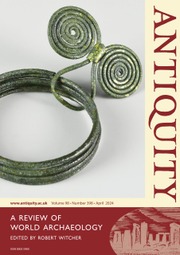Crossref Citations
This article has been cited by the following publications. This list is generated based on data provided by Crossref.
Robb, John
1993.
A social prehistory of European languages.
Antiquity,
Vol. 67,
Issue. 257,
p.
747.
Kadrow, Sławomir
1994.
Social Structures and Social Evolution Among Early Bronze-Age Communities in South-Eastern Poland.
Journal of European Archaeology,
Vol. 2,
Issue. 2,
p.
229.
Anthony, David W.
1995.
Horse, wagon & chariot: Indo-European languages and archaeology.
Antiquity,
Vol. 69,
Issue. 264,
p.
554.
Sims-Williams, Patrick
1998.
Genetics, linguistics, and prehistory: thinking big and thinking straight.
Antiquity,
Vol. 72,
Issue. 277,
p.
505.
Coningham, Robin
and
Lewer, Nick
2000.
The Vijayan colonization and the archaeology of identity in Sri Lanka.
Antiquity,
Vol. 74,
Issue. 285,
p.
707.
Bryant, Edwin
2001.
The Quest for the Origins of Vedic Culture.
p.
76.
2001.
The Quest for the Origins of Vedic Culture.
p.
v.
Bryant, Edwin
2001.
The Quest for the Origins of Vedic Culture.
Bryant, Edwin
2001.
The Quest for the Origins of Vedic Culture.
p.
108.
Bryant, Edwin
2001.
The Quest for the Origins of Vedic Culture.
p.
267.
Bryant, Edwin
2001.
The Quest for the Origins of Vedic Culture.
p.
298.
Bryant, Edwin
2001.
The Quest for the Origins of Vedic Culture.
p.
157.
Bryant, Edwin
2001.
The Quest for the Origins of Vedic Culture.
p.
124.
Bryant, Edwin
2001.
The Quest for the Origins of Vedic Culture.
p.
46.
Bryant, Edwin
2001.
The Quest for the Origins of Vedic Culture.
p.
197.
2001.
The Quest for the Origins of Vedic Culture.
p.
iv.
Bryant, Edwin
2001.
The Quest for the Origins of Vedic Culture.
p.
3.
Bryant, Edwin
2001.
The Quest for the Origins of Vedic Culture.
p.
57.
Sims-Williams, P.
2004.
DAY, J. V.: Indo-European Origins: The Anthropological Evidence.
Kratylos,
Vol. 49,
Issue. 1,
p.
39.
Sims-Williams, Patrick
2012.
Bronze- and Iron-Age Celtic-speakers: what don't we know, what can't we know, and what could we know? Language, genetics and archaeology in the twenty-first century.
The Antiquaries Journal,
Vol. 92,
Issue. ,
p.
427.

